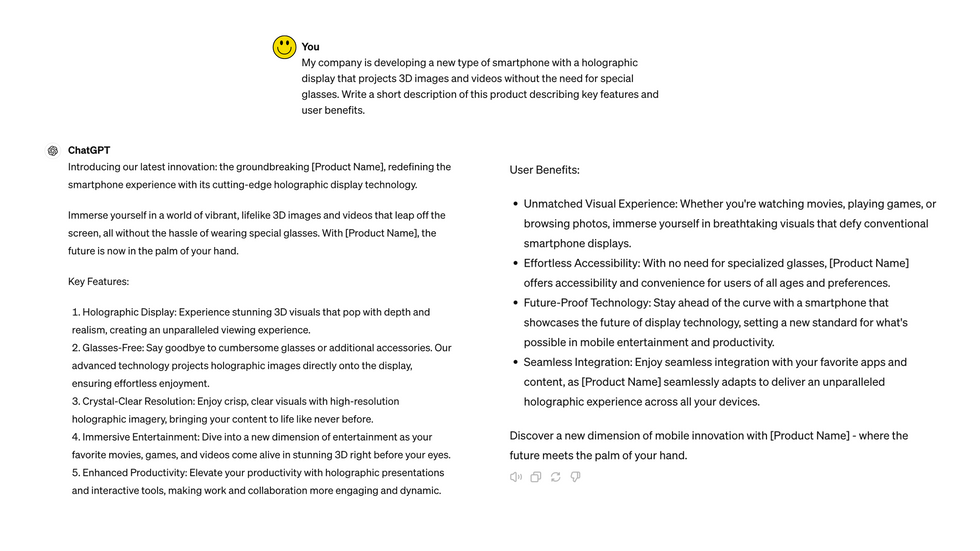Have you ever found yourself staring at a blank page, hoping for inspiration to strike? Whether you’re a writer looking for fresh ideas, a marketer seeking engaging content, or a problem-solver in need of creative solutions, generative AI is an amazing solution that is taking the world by storm.
But there’s one small problem. If you don’t know how to instruct the AI to do what you want it to do, you’re not going to get very far. That’s why prompt writing skills are so important.
In this blog post, we’ll give you some AI prompt writing tips to generate the best possible output. Plus, you’ll gain access to our AI Prompt Writing Guide so you can start harnessing the power of gen AI for your unique needs.
What is AI prompting?
AI prompting is the process of creating instructions for machine learning technologies or applications (a subset of AI) to generate a desired response. It involves providing an idea, request, or instructions in the form of text (the input), in order to receive a desired result (an output). Put simply, prompting is the way we ask an generative AI to do something.
Once it has the proper instructions, machine learning models harnesses natural language processing and large language models to fulfill the request, whether it’s generating text, conjuring up an image, or performing another type of task.
Let’s take a look at what AI prompting looks like in real life. We’ve prompted ChatGPT 3.5 with a brief description of a product, and we asked it to expand on the features and benefits of that product. Here’s what it came up with.
Prompt: “My company is developing a new type of smartphone with a holographic display that projects 3D images and videos without the need for special glasses. Write a short description of this product describing key features and user benefits.”
Results:
How to write a prompt for AI
Those results weren’t half bad, right? And the best part is, the result was delivered in under 10 seconds. It’s clear why AI technology is becoming more and more popular in the professional space. But you won’t get great results with instructions that are unclear or poorly written. Remember, prompts direct AI’s responses, and a well-written one ensures you receive a more accurate, in-depth result. Keep reading for some tips on how to write a prompt for AI.
Be clear with your ask. When writing a prompt for AI, ensure that your request is clear and concise. State exactly what you want the AI to do, whether it's writing an essay, solving a math problem, or providing creative ideas for your next social media post. Ambiguous prompts can lead to confusing or irrelevant responses, so clarity is key to getting the desired output.
Be specific. Provide precise instructions and details in your prompt. This will guide the AI to create an output that is accurate and relevant to your ask. Specify any requirements, constraints, or preferences to help narrow down the scope of the response.
Provide ample context. Give the AI enough background information and context to understand the task at hand. Explain the purpose of the prompt, any background information, and additional details or constraints that it should consider when generating a response.
Give examples and ideas. Offer concrete examples, scenarios, or ideas related to your prompt to inspire the AI and provide guidance on what kind of results you’re looking for. This will help you clarify your expectations and demonstrate the type of content or style you prefer, leading to better quality results.
Don’t forget about format. Consider the format and structure of your prompt, especially if you're asking the AI to generate text or provide specific information. Use clear and consistent formatting, such as bullet points, headings, or numbered lists to organize your prompt and make it easier for the AI to understand.
Taking things a step further
With these tips in mind, you’re just about ready to start your prompting journey. But there’s something you should know about AI that will affect your results. AI is biased. It’s known for reproducing limited ideas and stereotypes present in our society. To understand why this happens, you have to understand how machine learning technology works. It all starts with data — numbers, photos, text, videos, and more. Data is gathered and prepared to be used to train a machine learning model (MLM). These data sets are human-generated and, although they do a fairly good job at providing information, they also reflect the biases of society.
To demonstrate this, we used an AI image generator and asked it to create an image of an autistic person. Here are the results.
Pretty scary, right? While it’s obvious that not all autistic people are young, solemn, White males, somehow this idea is prevalent in the data sets used to train this model. These results aren’t surprising though, because some of the most popular television shows representing autism — The Good Doctor, Atypical, The A Word, among others — feature a young, White protagonist that looks eerily similar to some of the images above. This perpetuates stereotypes that can be harmful to folks of all identities.
In addition to the bias and stereotypes that AI tends to reproduce, there are other issues like a lack of regulations and unethical use of intellectual property that can sometimes make using AI a bit difficult to navigate. While it’s up to governments and big corporations to follow through with tighter laws and regulations around AI, there are some things that we can do as users to combat some of that bias that comes through.
Tips on on inclusive prompting
Don’t assume AI will do the work for you. While AI can assist in generating content, it's essential to remember that it operates based on the data it’s trained on. Be mindful of biases and stereotypes that may exist in the training data and actively work to mitigate them. Additionally, review and refine AI-generated outputs to ensure they align with ethical standards and promote inclusivity.
Be specific about what you want. Provide clear and detailed instructions in your prompts to guide the AI in generating inclusive content. Specify any requirements or considerations that should be reflected in the output. Take the above example for instance. If we specify that we want a young, Indigenous child with autism, you’ll get better aligned results. Specificity ensures that the AI produces outputs that consider diverse perspectives and avoid perpetuating harmful stereotypes or biases.
Research the ethics behind the AI tools you use. Before using AI tools, especially for content generation, take the time to research their ethical implications. Understand how the AI models were trained, what data was used, and any biases that may be present. Choose AI tools that prioritize fairness, transparency, and inclusivity in their development. Shutterstock recently launched an ethical AI art generator that pays artists for their work. You can stay up-to-date with the latest ethics in AI using sites like Holistic AI.
AI Prompting Guide
As you can see, there are a lot of things to keep in mind when writing prompts for AI. That’s why we put together this resource that you can use as a cheat sheet when writing your next set of instructions. It covers:
- Key elements of prompting
- Prompt structures with examples
- Prompt vocabulary banks
- Prompt priming tips
- And much more!
Fill out the form below to gain access to the AI prompt writing guide. And if you want to learn more about responsible AI, check out our new course called Inclusive AI Usage.






